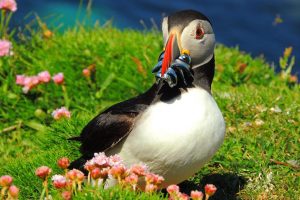Staffa & Fingals Cave Treshnish Wildlife Tour (Sails from August)
-
Departs:
Tobermory, Ardnamurchan
- 4 hours
£ 60
Staffa and Treshnish Isles Wildlife Tour from Fionnphort or Iona
-
Departs:
Iona, Fionnphort
- 6 hours
£ 85
It’s no secret that one of our favourite things to do on Staffa in the summer is puffin watching. These remarkable birds live most of their lives on the ocean, migrating to coastal regions during breeding season. They’re also incredibly friendly, and serve as one of the best attractions on our tours. Before taking one of our wildlife tours however, make sure to arm yourself with some amazing puffin facts!
Did you know that:
1. Puffins lay just one egg a year.
Like penguins, puffins usually mate for life – and a couple will rarely lay more than a single egg in a year. Also like penguins, both parents will usually take turns incubating the egg and looking after the chick.
2. Puffins are silent at sea.
Visiting puffins on Staffa can be a noisy affair. But despite making lots of noise when in large groups during the breeding season, at sea they remain completely silent.
3. There are eight isles named ‘Puffin Island’ around the world.
Like most birds, puffins are sociable creatures, especially during the mating season. Where they’ve colonised small islands, they’ve done so to such a degree that people have named islands after them eight separate times.
4. A puffin weighs about the same as a can of Coke.
Without perspective in photographs, it’s easy to imagine puffins as rather large birds. Only round 30cm in height, most Atlantic puffins weight about the same as a can of coke.
5. Puffins can hold 12 fish in their mouths at once.
Thanks to their well-adapted tongues and palates, puffins can comfortably carry around 10-12 small fish in their mouths at any one time. This great skill has played a huge role in their survival, allowing them to feed their young often and well.
Beloved by seasoned nature lovers and novices alike, puffins are truly one of the world’s most fascinating and remarkable creatures. They are a feature of all our most popular tours, and depending on their mood, they often interact with visitors throughout the season.
Want to know more about spotting puffins on the Isle of Staffa or the Treshnish Isles? Read all about how they migrate to Scotland from the Atlantic here.
Whether leaving from Oban, Mull, or Iona, book your tour today to see these incredible birds against one of Scotland’s most breathtaking backdrops.





